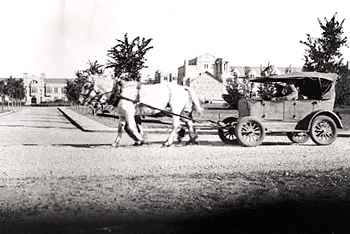The Bennett Buggy and the Hoover Wagon
By Rickie Longfellow
If your parents, grandparents or great grandparents had an automobile during the time of the 1929-1939 Great Depression, which wasn't great in the positive sense, chances are they didn't have money to operate a car.
In 1928, 4.6 million automobiles were sold. When the stock market crashed in October of 1929, many of those cars could not be used as gasoline prices increased and gas was soon rationed. As the wealth of the Roaring Twenties came to a screeching halt, many automobile owners in Canada and the United States decided the only reliable transportation was the old way-ride a horse or use a conveyance pulled by horses, mules, or oxen.
Many of these motorists made certain that the purchase of the automobile had been worthwhile. They removed the heavy engines, the windshields, windows, and other parts to lighten the weight of the vehicle. Then they hitched it to the team and went their merry way. These were called Bennett Buggies in Canada and Hoover Wagons in the United States, named after the respective leaders of their countries for whom the public placed the blame for the dire economic conditions. Research shows that the Bennett Buggy and the Hoover Wagon were not uncommon sights on public roads during the Depression years.
In a 1974 interview, conducted by Brigham Young University, a Depression era survivalist talked about his experiences during those lean years. Fortunately his family farmed and had plenty to eat, but gasoline was scarce. He said, ". . . we were taking the old chassis of cars and converting them into wagons, hay wagons, and we called them Hoover wagons."
During this time President Hoover's term was expired and Franklin Delano Roosevelt was elected as the 32nd President of the United States Enter the Works Project Administration (WPA), formed as part of President Roosevelt's New Deal. The program allowed millions of dollars to be spent on our Nation's highways putting thousands to work on the roads and once again putting food on the table of many Americans.
Until our Nation could pull itself out of the Great Depression, the Hoover Wagons and the Bennett Buggies would have good roads on which to travel, and until gasoline became accessible once again, a little hay and some oats fueled the team.

